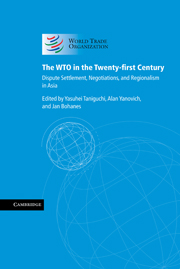Book contents
- Frontmatter
- Contents
- Notes on contributors
- Acknowledgements
- Table of dispute settlement cases and reports
- List of abbreviations
- Introduction
- PART I The WTO at Ten
- PART II Accomplishments and Future Prospects of the WTO Dispute Settlement System
- 3 The WTO dispute settlement system after ten years: the first decade's promises and challenges
- 4 WTO dispute settlement practice 1995–2005: lessons from the past and future challenges
- 5 Evaluating WTO dispute settlement: what results have been achieved through consultations and implementation of panel reports?
- 6 The responsibilities of a WTO Member found to have violated WTO law
- 7 ‘Public–private partnerships’ in WTO dispute settlement: the US and EU experience
- 8 Accomplishments of the WTO dispute settlement mechanism
- 9 Arbitration as an alternative to litigation in the WTO: observations in the light of the 2005 banana tariff arbitrations
- 10 The evolving WTO dispute settlement system
- PART III Asian Perspectives on WTO Dispute Settlement
- PART IV The Doha Development Agenda and Beyond
- PART V Asian Regional Integration and the Multilateral Trading System
- Index
3 - The WTO dispute settlement system after ten years: the first decade's promises and challenges
from PART II - Accomplishments and Future Prospects of the WTO Dispute Settlement System
Published online by Cambridge University Press: 05 March 2012
- Frontmatter
- Contents
- Notes on contributors
- Acknowledgements
- Table of dispute settlement cases and reports
- List of abbreviations
- Introduction
- PART I The WTO at Ten
- PART II Accomplishments and Future Prospects of the WTO Dispute Settlement System
- 3 The WTO dispute settlement system after ten years: the first decade's promises and challenges
- 4 WTO dispute settlement practice 1995–2005: lessons from the past and future challenges
- 5 Evaluating WTO dispute settlement: what results have been achieved through consultations and implementation of panel reports?
- 6 The responsibilities of a WTO Member found to have violated WTO law
- 7 ‘Public–private partnerships’ in WTO dispute settlement: the US and EU experience
- 8 Accomplishments of the WTO dispute settlement mechanism
- 9 Arbitration as an alternative to litigation in the WTO: observations in the light of the 2005 banana tariff arbitrations
- 10 The evolving WTO dispute settlement system
- PART III Asian Perspectives on WTO Dispute Settlement
- PART IV The Doha Development Agenda and Beyond
- PART V Asian Regional Integration and the Multilateral Trading System
- Index
Summary
The World Trade Organization (WTO) dispute settlement system is a vast subject, and provides a great opportunity to explore in more detail than I am allowed in this chapter. But I hope that this contribution will provide at least a framework for discussion.
Context and landscape: the world of interdependence and its realities
The general question of ‘globalization’
It is likely that the last decade of the 20th century, and the first decade of the 21st century, will be remembered as a period during which generally accepted assumptions of international law and international economic law were challenged in fundamental ways. Many of these challenges come from the factors that have lead us to the current period of globalization. Most significantly, these factors are the great reduction in the time and cost of both transport and communications, and the ‘refinement’ and ‘efficiency’ of weapons. These factors lead to circumstances that, on the one hand, require international cooperative institutions, but on the other hand, lead some policymakers to conclude that traditional notions of ‘sovereignty’ and the independence of the nation-state must be reserved for and, in certain circumstances, need to trump international institutions and their norms. One such international institution that cannot escape this landscape of facts ‘on the ground’, and the policies that relate to them, is the WTO. The natural trade barriers that existed a century ago, with respect to the factors just mentioned (transport and communication changes) have disappeared or have been deeply reduced, and the result is a degree of interdependence which has not, heretofore, been seen.
- Type
- Chapter
- Information
- The WTO in the Twenty-first CenturyDispute Settlement, Negotiations, and Regionalism in Asia, pp. 23 - 37Publisher: Cambridge University PressPrint publication year: 2007
- 1
- Cited by



